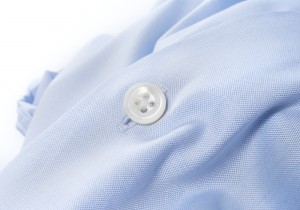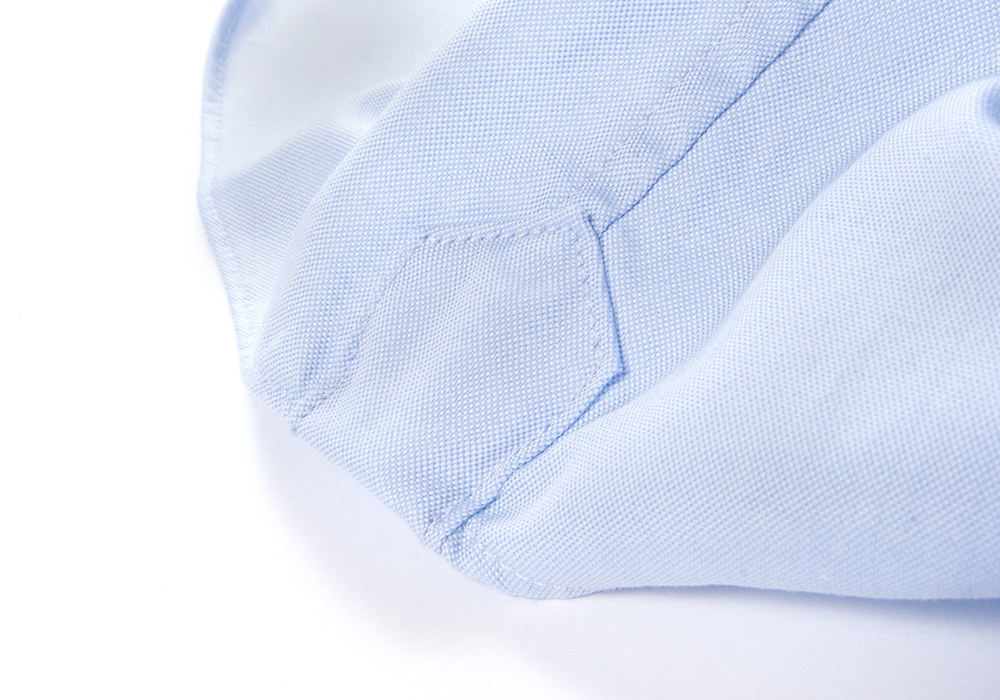What makes the perfect dress shirt? A careful combination of premium materials, high quality construction, design and fit. Here we break down some pointers.
Stiff, fused spread collar
Collars can be constructed using either a fused or unfused construction, and each is great for different settings. For the most part, if you’re in a business setting you’ll want the crisp, clean appearance of a stiff fused spread collar. They dress up great with a tie and stand at attention with a suit in a way that signals professionalism and competence.
While fused collars have become the standard in modern times, we’re also big fans of unfused collar construction in the proper setting. These collars have a very nice nonchalance to them and show a very elegant roll in their shape. Typically, these are more ideal for casual settings, but in the case of a relaxed office dress code that still like to dress up, these can have a very sophisticated look. By nature, they show slight wrinkling that is part of the relaxed appeal of this construction.
High quality detail: Split yoke
Look for signs of a high quality dress shirt construction such as a split yoke cut on the bias. The shirt yoke is the panel of fabric that runs across the shoulders, just behind the collar. Fine shirts will be made with what’s called a split yoke (it is made from two pieces of fabric and split in the middle). A true split yoke will have the two pieces of fabric cut at an angle. The stylistic benefit of cutting the fabric like this is that if the shirt has stripes or some kind of pattern, this pattern will run parallel to the front seam of the yoke, producing a neater look in the front In the back below the collar the stripes will meet in a chevron pattern. The functional benefit is that when a fabric is cut at this angle (also referred to as “cut on the bias”), the fabric stretches more length wise. This means you’ll have a greater range of motion when you’re reaching forward.
Premium white cotton fabric
We won’t go into this too much in this post, because dress shirt fabrics is a deep subject with varying opinions on thread count, ply, country of origin, mill, type of weave, yarn treatment, materials, etc. It all comes down to one thing though: the fabric makes the shirt. So get something comfortable that looks nice. Most dress shirts are made with 80 thread count fabric and nicer shirts are usually made with higher thread count fabrics. We caution you stay away from blended fabrics for your dress shirts and stick to 100% cotton for comfort and breathability. What fabric you prefer is up to you.
Slim fitting midsection
Similar to the slim cut sleeves, a tapered midsection adds to a polished look by removing unnecessary fabric. Especially if you have an athletic build, you’ll find that most off the rack shirts will naturally billow out around your waist. A slim fitting tapered midsection will compliment your physique and make your entire outfit look more flattering.
 High quality buttons
High quality buttons
Buying a well-constructed dress shirt with quality fabrics means that you won’t want to skimp on cheap buttons. We favor high-quality Mother of Pearl buttons for their depth of color and shine, but there also some high quality composite plastic resin buttons that are attractive and even more durable than their natural alternatives.
Smaller arm holes
Now we’re getting into the shape of the shirt, which should be considered just as important as the fabric it’s made from. Most off the rack shirts come with very large arm holes (to accommodate the widest range of body types) although some designers are now making their shirts with tighter armholes. The benefit of a smaller arm hole is part appearance (it’ll make you look a little sharper and slimmer) and part function (a smaller arm hole better isolates the movement of the arm from the rest of the body allowing you to move your arms without pulling the body of your shirt all over the place).
Stiff, fused cuffs
It doesn’t really matter if we’re talking about French cuffs or barrel cuffs. Like collars, you can get either fused or unfused construction–the appeal of each is the same as it is with collars: fused for a clean, professional look and unfused for a relaxed, casual vibe. They should be hand sewn and this is where experience, skill, and patience makes a difference. It takes a lot of focus, practice and time to get the details on the cuffs right and it will show the most in the pointedness of the corners and the straightness of the stitching.
 Reinforced side seam gussets
Reinforced side seam gussets
The last thing you want is for your new dress shirt to start coming apart at the seams (literally). That’s where reinforced side seam gussets come in. We’ve heard guys complain that their past shirts tear at the bottom of the side seam, so we add this little bit of fabric to add to the life span of your shirt.
The perfect shirt length
Think about how you’ll wear your shirt. Solely with a suit in a professional setting? You’ll want your shirt on the longer side so that it never becomes untucked when you’re in the middle of a presentation. Wearing it to work then to the bar after? You may want to find a sweet spot that stays tucked in throughout the day, but is short enough to wear untucked when you’re out at night. Think about your usage and find the right length for you. You’d be surprised how much length can factor in to how much you like your dress shirt.